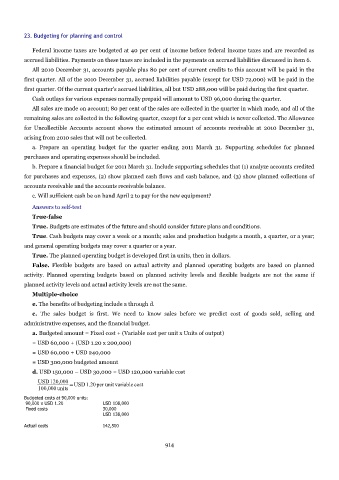Page 913 - Accounting Principles (A Business Perspective)
P. 913
23. Budgeting for planning and control
Federal income taxes are budgeted at 40 per cent of income before federal income taxes and are recorded as
accrued liabilities. Payments on these taxes are included in the payments on accrued liabilities discussed in item 6.
All 2010 December 31, accounts payable plus 80 per cent of current credits to this account will be paid in the
first quarter. All of the 2010 December 31, accrued liabilities payable (except for USD 72,000) will be paid in the
first quarter. Of the current quarter's accrued liabilities, all but USD 288,000 will be paid during the first quarter.
Cash outlays for various expenses normally prepaid will amount to USD 96,000 during the quarter.
All sales are made on account; 80 per cent of the sales are collected in the quarter in which made, and all of the
remaining sales are collected in the following quarter, except for 2 per cent which is never collected. The Allowance
for Uncollectible Accounts account shows the estimated amount of accounts receivable at 2010 December 31,
arising from 2010 sales that will not be collected.
a. Prepare an operating budget for the quarter ending 2011 March 31. Supporting schedules for planned
purchases and operating expenses should be included.
b. Prepare a financial budget for 2011 March 31. Include supporting schedules that (1) analyze accounts credited
for purchases and expenses, (2) show planned cash flows and cash balance, and (3) show planned collections of
accounts receivable and the accounts receivable balance.
c. Will sufficient cash be on hand April 2 to pay for the new equipment?
Answers to self-test
True-false
True. Budgets are estimates of the future and should consider future plans and conditions.
True. Cash budgets may cover a week or a month; sales and production budgets a month, a quarter, or a year;
and general operating budgets may cover a quarter or a year.
True. The planned operating budget is developed first in units, then in dollars.
False. Flexible budgets are based on actual activity and planned operating budgets are based on planned
activity. Planned operating budgets based on planned activity levels and flexible budgets are not the same if
planned activity levels and actual activity levels are not the same.
Multiple-choice
e. The benefits of budgeting include a through d.
c. The sales budget is first. We need to know sales before we predict cost of goods sold, selling and
administrative expenses, and the financial budget.
a. Budgeted amount = Fixed cost + (Variable cost per unit x Units of output)
= USD 60,000 + (USD 1.20 x 200,000)
= USD 60,000 + USD 240,000
= USD 300,000 budgeted amount
d. USD 150,000 – USD 30,000 = USD 120,000 variable cost
USD120,000 =USD1.20per unit variable cost
100,000 units
Budgeted costs at 90,000 units:
90,000 x USD 1.20 USD 108,000
Fixed costs 30,000
USD 138,000
Actual costs 142,500
914

